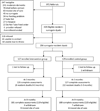Improving decision-making for feeding options in advanced dementia: a randomized, controlled trial
- PMID: 22091750
- PMCID: PMC3227016
- DOI: 10.1111/j.1532-5415.2011.03629.x
Improving decision-making for feeding options in advanced dementia: a randomized, controlled trial
Abstract
Objectives: To test whether a decision aid improves quality of decision-making about feeding options in advanced dementia.
Design: Cluster randomized controlled trial.
Setting: Twenty-four nursing homes in North Carolina.
Participants: Residents with advanced dementia and feeding problems and their surrogates.
Intervention: Intervention surrogates received an audio or print decision aid on feeding options in advanced dementia. Controls received usual care.
Measurements: Primary outcome was the Decisional Conflict Scale (range: 1-5) measured at 3 months; other main outcomes were surrogate knowledge, frequency of communication with providers, and feeding treatment use.
Results: Two hundred fifty-six residents and surrogate decision-makers were recruited. Residents' average age was 85; 67% were Caucasian, and 79% were women. Surrogates' average age was 59; 67% were Caucasian, and 70% were residents' children. The intervention improved knowledge scores (16.8 vs 15.1, P < .001). After 3 months, intervention surrogates had lower Decisional Conflict Scale scores than controls (1.65 vs 1.90, P < .001) and more often discussed feeding options with a healthcare provider (46% vs 33%, P = .04). Residents in the intervention group were more likely to receive a dysphagia diet (89% vs 76%, P = .04) and showed a trend toward greater staff eating assistance (20% vs 10%, P = .08). Tube feeding was rare in both groups even after 9 months (1 intervention vs 3 control, P = .34).
Conclusion: A decision aid about feeding options in advanced dementia reduced decisional conflict for surrogates and increased their knowledge and communication about feeding options with providers.
Trial registration: ClinicalTrials.gov NCT01113749.
© 2011, Copyright the Authors Journal compilation © 2011, The American Geriatrics Society.
Figures
References
-
- Hebert LI, Scherr PA, Bienias JL, et al. Alzheimer’s disease in the US population: Prevalence estimates using the 2000 census. Arch Neurol. 2003;60:1119–1122. - PubMed
-
- Larson EB, Shadlen MF, Wang L, et al. Survival after initial diagnosis of Alzheimer disease. Ann Intern Med. 2004;140:501–509. - PubMed
-
- Boustani M, Peterson CB, Hanson LC, et al. Screening for dementia syndrome: A review of the evidence. Ann Intern Med. 2003;138:927–937. - PubMed
-
- Reisberg B, Ferris SH, De Leon MJ, et al. The global deterioration scale for assessment of primary degenerative dementia. Am J Psychiatry. 1982;139:1136–1139. - PubMed
Publication types
MeSH terms
Associated data
Grants and funding
LinkOut - more resources
Full Text Sources
Medical


